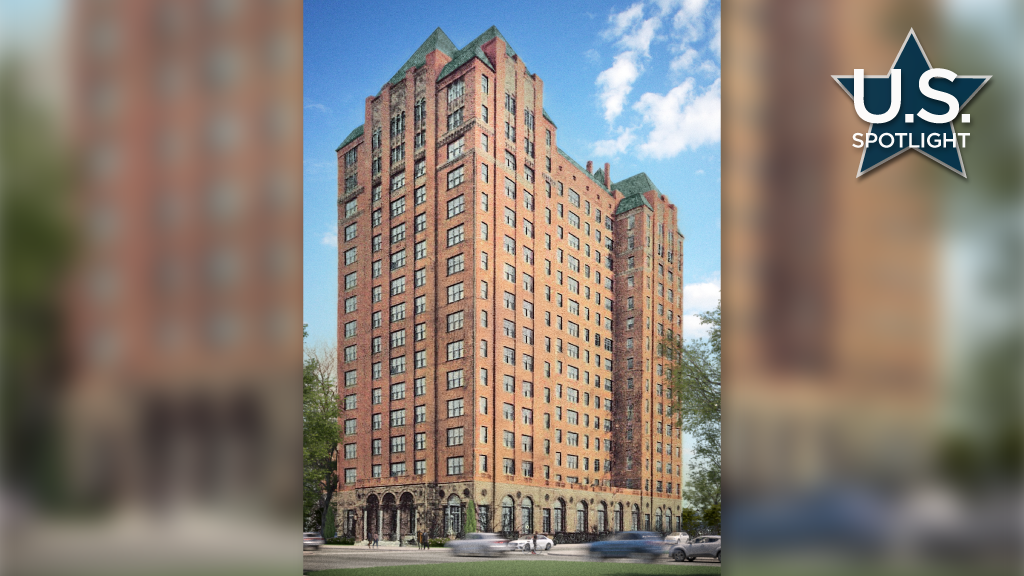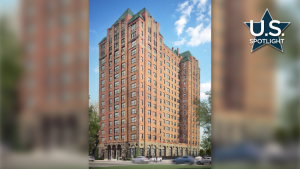The Lee Plaza was a 1920s era luxury hotel that, like myriad other buildings in Detroit’s post-1960s history, had fallen dramatically into disuse and blight.
Now, after a multiyear thicket-like effort to raise financing, ground was broken last month on the 15-storey building’s restoration.
Perhaps as testament to the long struggle to reopen the northwest Detroit building, more than 100 civic leaders and community members gathered for the groundbreaking, led by Mayor Mike Duggan, who personally had placed the building’s renewal among the top of his priority list.
“Lee Plaza is one of the most beloved buildings in our city, not only because of its architectural beauty, but because it’s in a neighborhood,” he said.
A bit of background.
The historic hotel, an Italianate Art Deco masterpiece with its orange glazed brick, exterior tile and sculpture, also featured iconic stone lions’ heads. It was later converted to low-income housing before closing permanently in the 1990s. So much of the building was since gutted and vandalized that even those lion heads were stolen and its pitched roof stripped of copper leaving only frames.
Unlike other recent Detroit revitalization projects of early 20th century ruins, which have occurred mainly in the city’s core, Lee Plaza is several miles north, though about a mile from a one-time secondary business district known as New Center, the site of General Motors Corp.’s former world headquarters.
Also, the original Henry Ford Hospital was less than a mile away.
“West Grand Boulevard was a real center of economic activity, certainly given the construction of General Motors a little further down from there,” urban studies professor Jeff Horner of Wayne State University says. “It was kind of all of a piece. It was all on a major road with a luxury hotel. The markets were there, or the rents were there in 1929, when it was completed.”
In the modern era, the surrounding Northwest Goldberg neighborhood had also fallen into acres of urban decay so characteristic of Detroit’s post-industrial and depopulation plight.
Nevertheless, the mayor, who called the project his “obsession,” along with several key local developers, have worked relentlessly to revitalize the structure. Earlier attempts over the past decade by developers to rebuild it fell through because deals weren’t completed or the city rejected applicants.
Now, The Roxbury Group – a company that has revitalized many old city buildings led by dedicated and credible ownership – is spearheading the $50 million development.
Its partners are also local, Ethos Development Partners and Lighthouse. The contractor is Detroit-based Sachse ������ion, architect Fusco, Shaffer & Pappas assisted by historic preservation firm Kidorf.
“This is the culmination of a seven-year effort in collaboration with the City of Detroit and the State of Michigan,” David Di Rita, principal of The Roxbury Group, said at the groundbreaking. He called Lee Plaza the city’s “last vacant highrise.”
The complex financing includes several layers of city, state and federal grants and tax credits as well as private investment from RBC and JP Morgan Chase.
The plan is to convert the building into 117 affordable seniors housing units with a further 65 market priced apartments on the top five floors.
Horner says the redevelopment comes at the same time as Henry Ford Hospital’s $2.5 billion redevelopment as well as a neighborhood residential renaissance.
“The (1920s era) houses are in great shape,” he said. “People are moving in and renovating them.”
As well, another renewal project on West Grand Boulevard, that of the world-famous Motown Museum, will next year open its expanded $75 million campus between Lee Plaza and Henry Ford.
And those terra cotta lions’ heads will also be recreated.











Recent Comments
comments for this post are closed